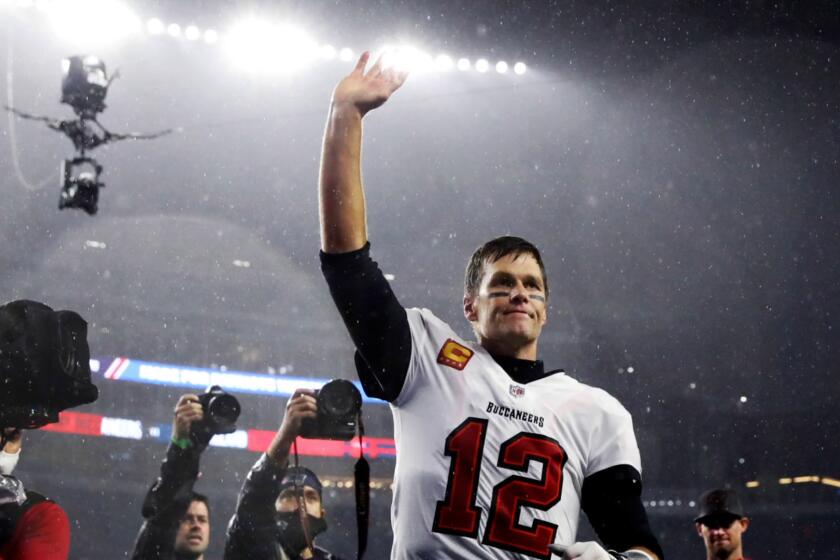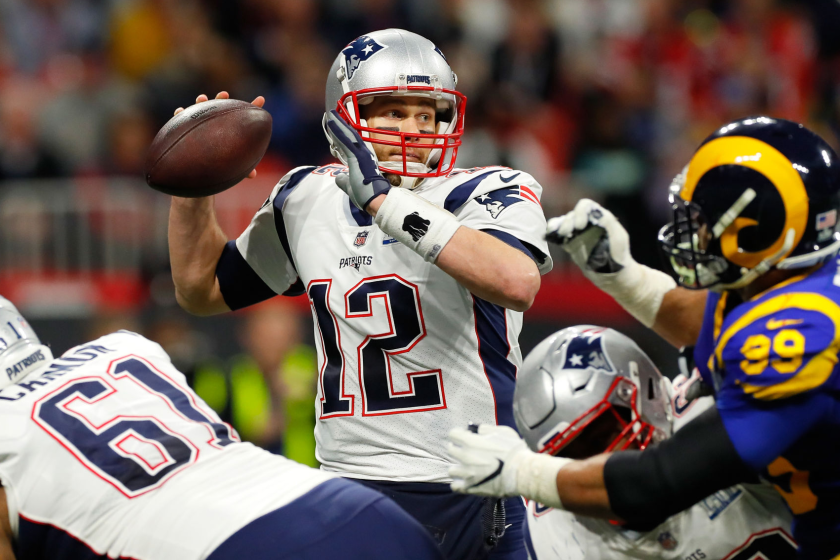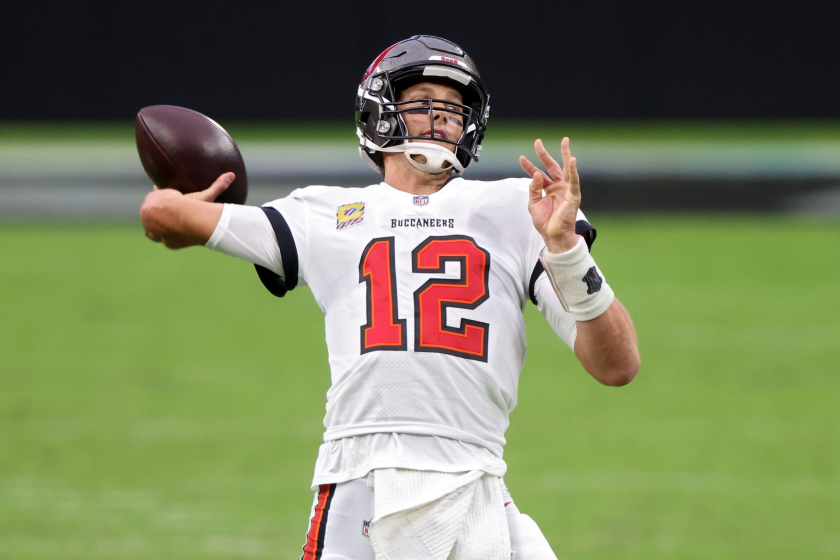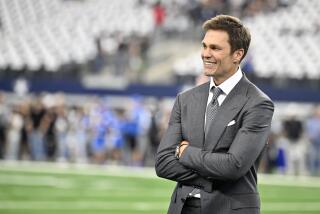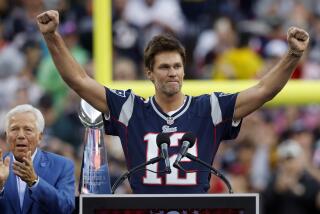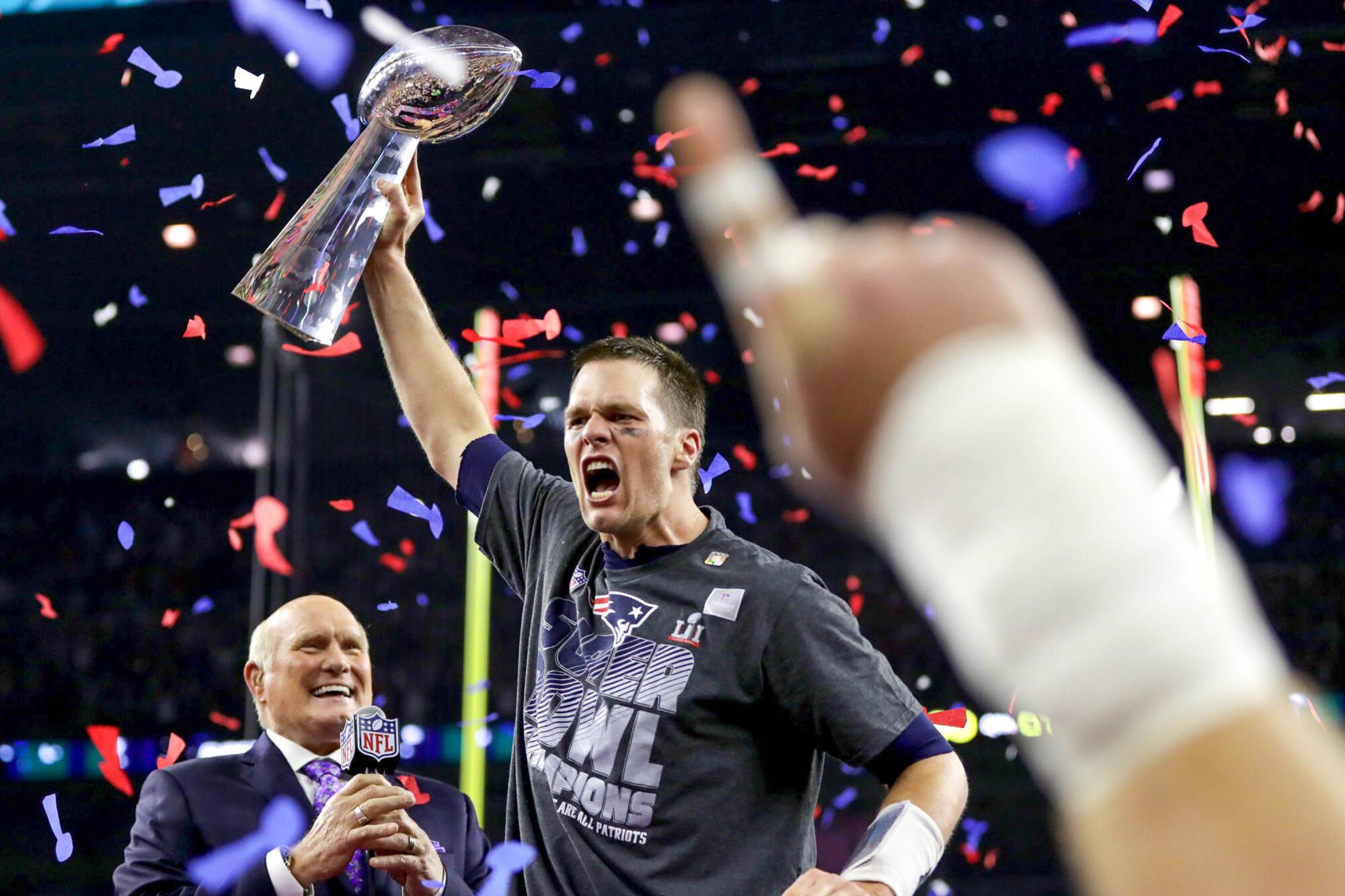
- Share via
The press box was suddenly hushed. I’ll never forget the sound of that hush.
It was two Sundays ago in Tampa, Raymond James Stadium, the Rams playing the Tampa Bay Buccaneers in the NFC divisional playoff.
For nearly three hours, the Rams were dominating, leading by 24 points, and my working brethren were relaxed, chatting, loudly typing stories that would be completed long before the end of the game.
Then, in the flash of a GOAT, everything changed.
Tom Brady went to work. And the press box grew sweepingly silent, awestruck, entranced, because everyone knew.
At age 44, in his 22nd season, Tom Brady was still scary as hell.
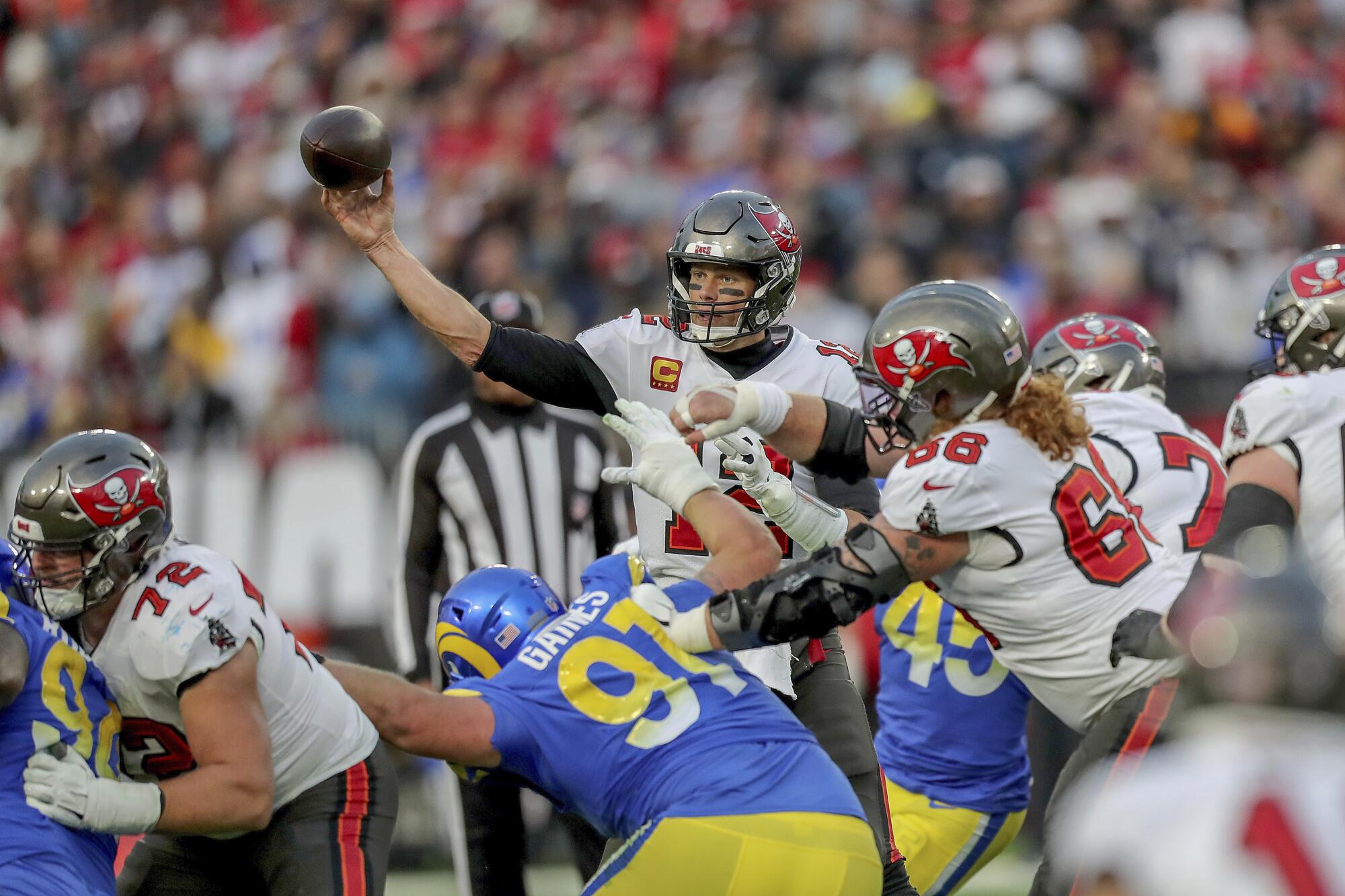
Brady completed five straight passes to set up a field goal. Brady completed three straight passes to set up a touchdown. Brady completed a 55-yard pass for another touchdown. Brady completed a perfect pass over the middle to set up a game-tying touchdown.
That last throw was a nine-yard dart through traffic to Cameron Brate, a beautiful toss that would eventually sail into history.
It would be the last pass of his career.
Brady announced his retirement Tuesday, and how perfect that he ended his playing days still fighting, still climbing, still able to mount a 24-point comeback with a greatness that made anything possible.
The Rams won Tom Brady’s last game, but they only won it because he was on the bench, helpless to stop a last-second field goal drive. They only won by taking the ball out of his hands, sitting him down, and making him watch.
Tom Brady didn’t run out of talent, he ran out of time. He didn’t stumble out of his final moments, he marched boldly away. Even while taking his last competitive breaths, Tom Brady nearly pulled off a miracle.
Tom Brady, who won six Super Bowls with the Patriots and one with the Buccaneers, announced his retirement on social media Tuesday.
He is so magical, folks crowded around one of the Raymond James Stadium tunnels after Sunday’s game just to watch him walk off.
He is taller than one would think, his 6-foot-4 frame often dwarfed by the giant linemen around him. He also looks older than one might imagine, the years showing on his face in ways they never appeared in his arm.
Indeed, of all the amazing numbers accompanying the career of the greatest player in the history of America’s most popular sport, his last ones are perhaps the most shocking.
Who retires after a season in which he led the league in touchdown passes and passing yards?
He didn’t just retire on his terms, he retired on heaven’s terms, leaving so powerfully at the top of his game that, in the end, even a four-game suspension for deflating footballs in 2015 cannot take much air out of his greatness.
He has thrown for more touchdown and yards than anyone in NFL history, but his legacy centers around his seven Super Bowl championships, the most ever by an NFL player. That history is only enhanced when one realizes he won six titles in one place with one coach . . . then bolted 1,350 miles south and won another one with a new team and a new coach.
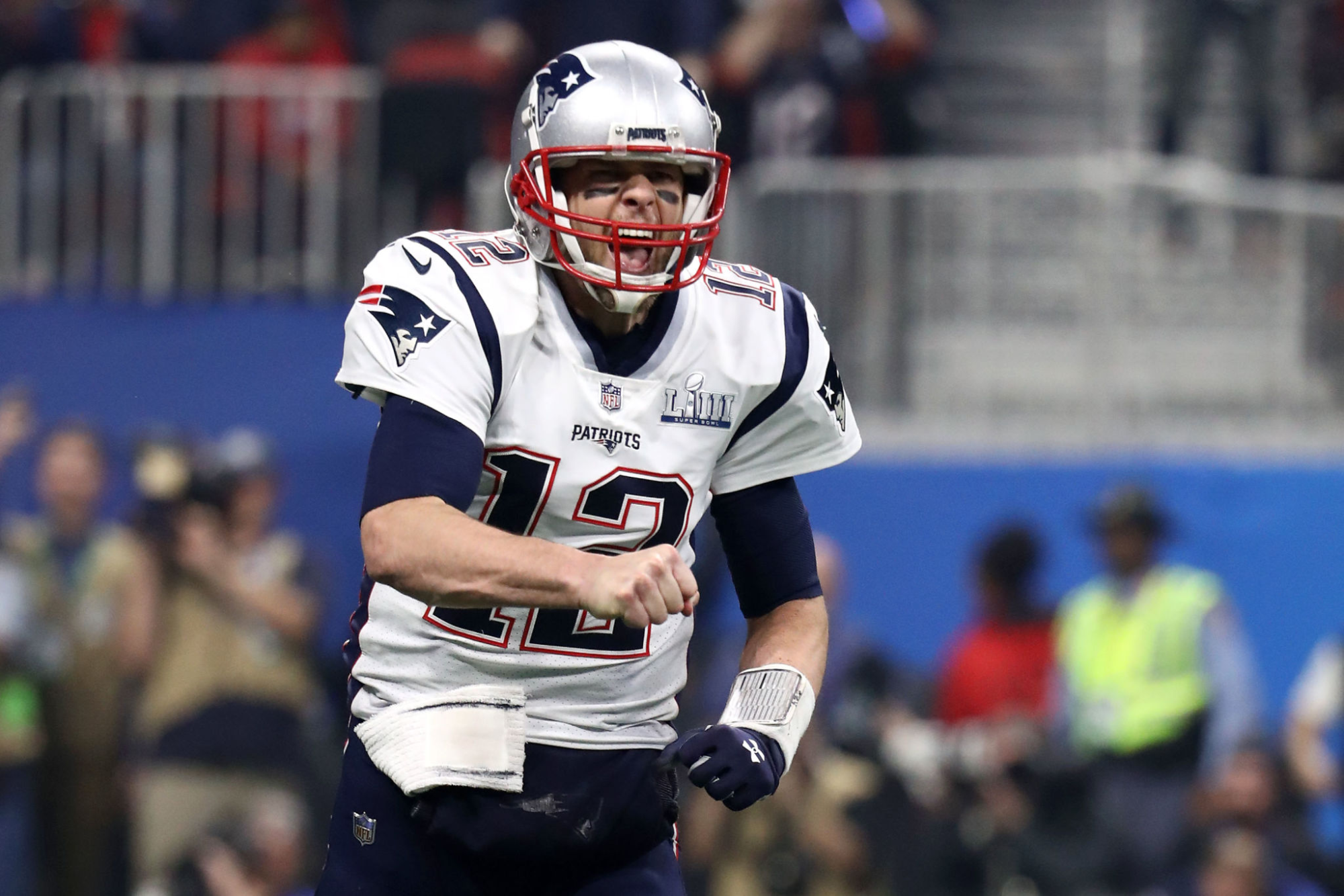
Make no mistake, the main reason for the success of the New England Patriots was not coach Bill Belichick, but Tom Brady. They haven’t won a playoff game in the two years since Brady left.
Also make no mistake, the main reason for the success of the Bucs was also Brady, and here’s guessing that with his retirement, they fade back into anonymity.
In the history of American sports, only the NBA’s Michael Jordan had such a singular triumphant effect on the fortunes of one team. Brady and Jordan share another legacy that is even more inspirational, particularly for anonymous gym rats and sandlot players everywhere.
Before they became untouchable, both were unwanted.
Nearly a USC Trojan, maybe even a Charger, Tom Brady found his way into the story of L.A. football right up until the week before he retired.
While Jordan was famously cut from his high school junior varsity team, Brady was given little chance of great success even after a strong college career at Michigan.
In the 2000 draft, Brady was only the 199th player picked, the Patriots’ sixth-round selection who showed little potential in the draft combine. One of the most compelling photos in football history is his draft combine portrait featuring a scrawny shirtless kid in gym shorts and a bad haircut.
He began his rookie season as a fourth-stringer, and completed only one pass all season. But in his second season, he replaced injured Drew Bledsoe in the second game, led the Patriots to a Super Bowl championship, and the rest is legend.
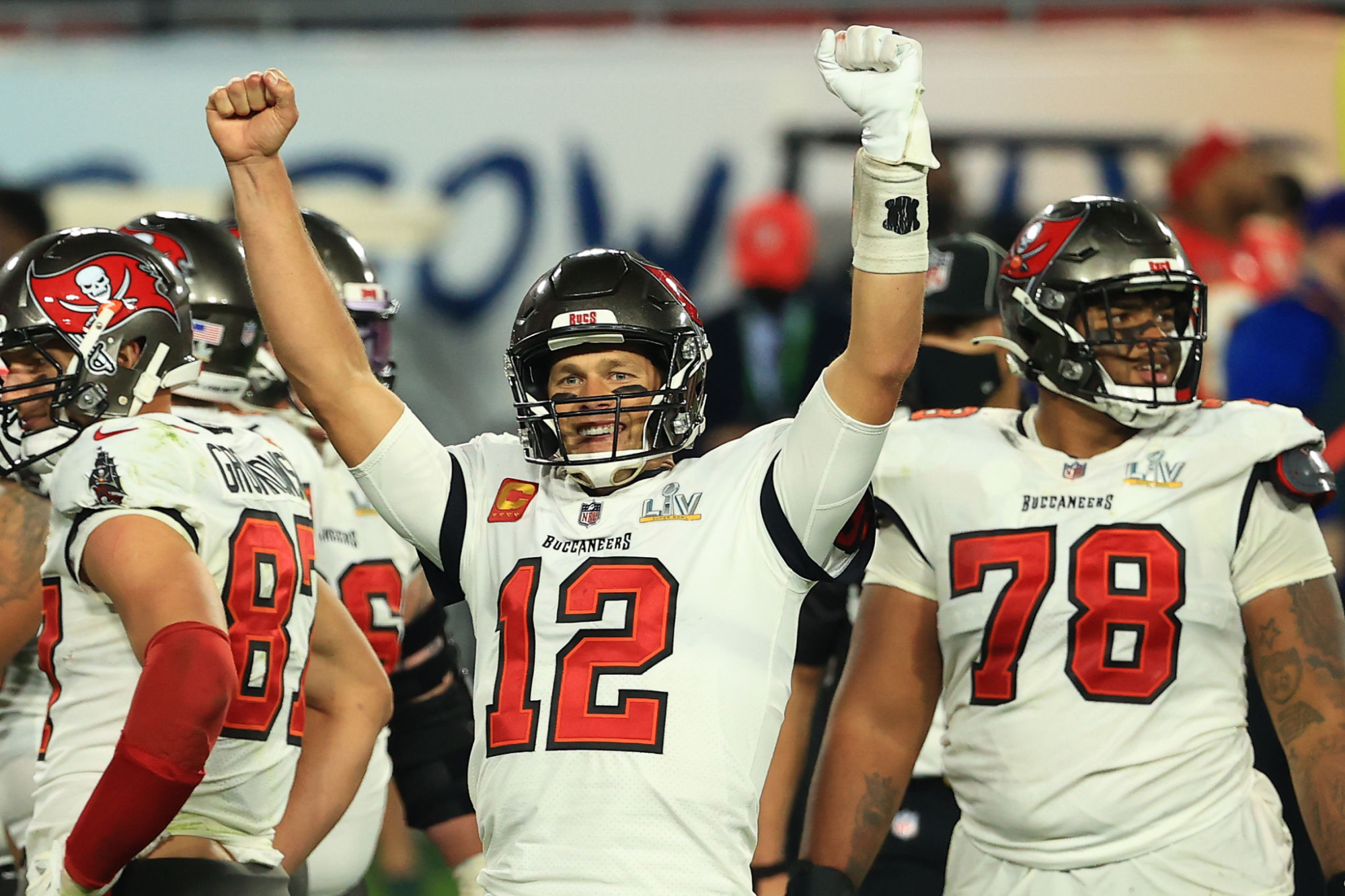
You may not read this in his many tributes, but it can’t be forgotten that part of that legend was cheating.
After he won his fourth championship following the 2014 season, Brady was suspended for four games for his alleged involvement in the deflating of footballs before the AFC championship game against the Indianapolis Colts. Brady initially appealed, but his decision to destroy his cellphone during the investigation led the league to uphold the suspension, which he served at the start of the 2016 season.
Did he knowingly cheat? The evidence supports that he was at least aware of the cheating, so, yes. Was the suspension fair? Considering that he was uncooperative with investigators and destroyed potential evidence, yes, it was fair.
But should that incident stain the rest of his career? Considering he won three more Super Bowls after “Deflategate” and stayed clear of any further on-field controversy, he seemingly earned the right to put it in the past.
Trent Dilfer, Steve Young, Rich Gannon and Matt Hasselbeck break down what makes Tom Brady arguably the greatest quarterback in NFL history.
In fact, arguably the most compelling part of Brady’s journey was that he was greatest athlete in today’s sports culture who was able to navigate the treacherous gap from animosity to affinity.
In the first third of his career, many of those living outside the New England area looked upon him as the arrogant embodiment of the infamous Patriot Way. In the middle of his career, he was reviled as being the epitome of the Patriots’ reputation for cheating. Yet in the final stage of his career, even his critics begrudgingly came to respect him as a survivor and a legitimate champion of the sport.
I was there for his first big game, in New Orleans in 2002 when he led the Patriots downfield for the game-winning field goal to beat the St. Louis Rams in the Super Bowl XXXVI.
I was also there for his last big game, in Tampa 20 years later, with the loss to the Rams on Jan. 23.
I can safely say that there was little difference between the two Tom Bradys. Amazing then. Amazing now. A retirement completely expected, and yet so sudden.
The football world cheers. The football world is hushed.
More to Read
Go beyond the scoreboard
Get the latest on L.A.'s teams in the daily Sports Report newsletter.
You may occasionally receive promotional content from the Los Angeles Times.

